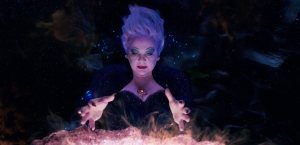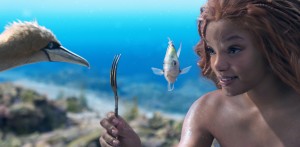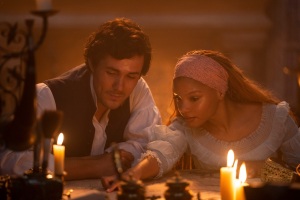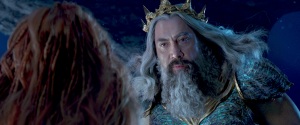SPOILER ALERT: This interview includes details about Disney’s The Little Mermaid
Good tides and accolades continue to roll in for Disney’s latest live-action remake, The Little Mermaid. Similarly to the 1989 classic, The Little Mermaid follows the story of the titular mermaid, Ariel, a precocious teenager who yearns to walk amongst the sun-soaked earth of the human world. Since the film’s debut over the three-day weekend, it made an impressive box office splash to the tune of $95.5M and is projected to set sail towards $163.8M, factoring in the international markets as it makes its global debut through Sunday. It seems that The Little Mermaid’s continued success is due in no small part to the transformative magic of the film’s onscreen players, whose modernized performances offer more to chew on this time around than its animated predecessor, warranting repeat visits to the movie theater.
Here, Deadline talks with The Little Mermaid stars Halle Bailey (Ariel), Jonah Hauer-King (Prince Eric), Melissa McCarthy (Ursula), and Javier Bardem (King Triton) alongside director-producer Rob Marshall and producer John DeLuca about creative changes, how they got into character, the challenges of the filming process and more.
(L-R): Halle Bailey as Ariel and Javier Bardem as King Triton in Disney’s live-action The Little Mermaid
Disney
On expanding the father-daughter relationship and Ariel’s sense of agency
Though the ending only deviates slightly from the original animated film, it makes a big impact on and off-screen. In the live-action adaptation, not only does King Triton reconcile with his beloved youngest daughter’s full autonomy, but he also compounds his realization with an apology declaring that Ariel has the right to be seen and heard. It’s a powerful moment considering how women, and especially women of color, often feel silenced when speaking up for themselves, which also abides by the recurring theme in the film itself.
Bailey explained why that change in the film resonated with her. “That ending is really a great version, and it shows her strength and power throughout the film,” the actress said. “You’re seeing Ariel transform in front of your eyes, where at the beginning she’s a little bit shy and timid and frustrated because the beautiful things she’s voicing about herself and her future and her wants and needs aren’t being heard. And so, for her to go out of her way to burst through to the world that she doesn’t know, and for her to be brave enough to do so and come out on top the way she did, and fighting for love and friendship and family at the heart of the film is just, it’s so cool to see. So, I definitely say moments like the ending were really impactful to me, and I was happy to see that transformation in Ariel.”
Bardem, who has two children with actress Penélope Cruz, reflected on his own experience as a father to dictate the emotional impact and understanding of that scene. “As parents, father and mother, we want to protect [our children]. We want to make sure that they are not suffering and that they don’t suffer. But life is about joy and pain, all the gray areas and the ups and downs. Those are the things that you cannot avoid. And you have to be there for them, but also let them go and have their own journey. And he realizes that, and it is not easy. I know.”
The importance of adding the Hans Christian Andersen quote
The opening of the live-action musical is a bit foreboding as it shows dark, choppy waters cascading over a rock as the text reads: “But a mermaid has no tears, and therefore she suffers so much more.” It’s a quote (and homage) to the Danish author who penned The Little Mermaid story in 1837, but the animated Disney film didn’t do it. So why did Marshall and DeLuca decide to?
“The quote for me has such depth to it,” Marshall said. “It says, ‘Look what she’s going to go through to get [to her end goal].’ You know what I mean? That she has to struggle to find her way. That’s really what this film’s about. You don’t ever give up. And the fact that a mermaid has no tears is why they feel so much more. To me, it sets the table for the whole piece. There’s much more emotion, depth and stakes to what she’s trying to achieve. And at the end, when she becomes a full human, she sheds a tear and can finally feel what humans feel. That was very profound for us. And we found this depth to this film and this story directly from Hans Christian Anderson. But there was so much more to bring to a live-action film than a 2D animated film, which is so beloved and wonderful. But in this genre, we get to do something deeper.”
On the turbulent waters, DeLuca added: “We also wanted to start it out with those crashing waves and the turbulence of those waves and juxtapose that with what we both fell in love with the Hans Christian Anderson tale and really bring that into this realization.”

Melissa McCarthy as Ursula in Disney’s live-action The Little Mermaid
Disney
How stars Jonah Hauer-King and Melissa McCarthy reinterpreted their roles for the live-action remake
Say goodbye to the animated heartthrob of yesteryear, and say hello to Hauer-King’s restless rendition of the dashing rogue, Prince Eric.
This time around, influenced by Marshall’s direction and co-writers David Magee and Jane Goldman, Prince Eric is so much more than a handsome face with few words to say to the mysterious siren that saved his life. He’s frenzied, wracked with inner turmoil, and has a penchant for mischief and adventure. “A big part of what Rob said to me from the beginning was that we need to have an Eric who is layered and complex and someone we understand as a human being, not just as a prince archetype,” Hauer-King said. “And I think when we meet him, he is quite lost. He knows that there’s something out there that he wants. And I think him being saved by this mystery girl is a catalyst for that. It sparks this journey in him wanting to break free from the four walls of the castle.”
Hauer-King also describes his take on Prince Eric’s slight dissociation from reality, where he questions his own sanity, on the shore while he watches Ursula and Ariel battle it out in the ocean–yet another deviation from the animated film. “That scene at the end… he’s so sure in his heart of what he wants [which is Ariel], but he also knows that [their love] seems so hard to get and seems so impossible to achieve. But deep down, he knows it’s what’s right and what he wants. And I think that’s really beautiful, because it’s moving to think that that’s not the way it’s going to go and that [their romance might] not happen. So, when that reunion does happen, it feels really satisfying and, hopefully, really joyful.”
McCarthy makes a deviously delightful turn as the sea witch Ursula. The film reveals that she’s King Triton’s sister, who was banished for unbeknownst reasons from the kingdom of Atlantica. This minor addition to the story humanizes her in a way that the original animation could not.
Still taking inspiration from Pat Carroll’s version, McCarthy managed to strike a balance in her portrayal. “I really love Pat Carroll’s original version. She was so dishy, and Divine had a big influence on that performance. I have such love for the original, but I did know I have to, at a certain point, shake off the nerves and just try to interpret her like I would do any other character,” the actress said. “She’s so funny, she’s sharp, she’s manipulative. But as I often like to do, I usually think in terms of people’s armor. I’m weirdly obsessed with how people and characters present themselves to the world and what it is deflecting that people don’t see. And with Ursula, it’s the makeup, the bustier and the attitude. It’s wonderful, but I think it deflects her mental health and loneliness. She’s been isolated and shunned by her family. And that kind of hurt is so deep, especially within family, that those who should love you most have actually put you away for a decade and a half. And what she’s left with by the end of it, I’ve always loved her, but I really fell in love with her, and I feel like I had such great compassion for her and sympathy.”

(L-R): Scuttle (voice: Awkwafina), Flounder (voice: Jacob Tremblay), Halle Bailey as Ariel in The Little Mermaid
Walt Disney Studios Motion Pictures / Courtesy Everett Collection
The most fun challenge while filming
Despite what Sebastian might think about life being nothing but bubbles under the sea, executing a water and CGI-based production was no easy feat. When asked about the most challenging scene to adapt to screen, DeLuca joked that it was “every scene.”
“Underwater was so complicated,” Marshall added. “But our goal was never to let you see the machinery behind it all because sometimes there would be… In “Part of Your World,” Halle would sing two lines, and we’d say, ‘Cut,’ and then she’d be back on another piece of equipment or apparatus. It was all choreographed in advance. But then it was so complicated to think, ‘How do we do an underwater musical, really?’ It’s never been done before. So that was the goal, to make sure the audience doesn’t see any of that.”
For the “Under the Sea” sequence, DeLuca and Marshall pulled influence from how Walt Disney animated huge sequences in 1940’s Fantasia. “Because we are with one live actor in a massive production number, the first thing we thought was that we needed something to work from,” Marshall recalled. “And I thought about Walt Disney and remembered that in Fantasia, he had worked with the Ballet Russes Company, a ballet company, to use as a template for his animators to create the sequence. And I thought, we should work with a company. And we brought the Alvin Ailey American Dance Theater over to London, where we were working, and we created the number on them. Their bodies were replicating different sea creatures, so our CGI animators would have a template to work from to create this massive production number. It was one of the most challenging things, and we’ve done a few production numbers in our life, but this was the craziest one.”
DeLuca added, “That one cracked any fear we had, though.”
For Bailey and Hauer-King, their challenge was physical. “Whenever I think of fun and hilarious, I think of all the tank work Jonah and I had to do together,” Bailey said. “We had to be very serious in the middle of a thunderstorm, but it was quite hard to be serious when we’re terrified in the middle of this water rainstorm that feels like you’re in the middle of the ocean, and then I had to lift Jonah up. And if anyone has seen us stand next to each other, he towers over me. So, we were laughing at that. It was just a really good moment.”
Hauer-King added, “It was a great bonding experience. And also Rob, he’s a visionary and a perfectionist, so he knows what he wants. And we’d be in that tank for a long time. We’d be like, ‘So that take was pretty good, right? We could probably go now.’ And he’s like, ‘Do it again, get back in, we haven’t got it yet.’ It might have taken hours, weeks, months, years.”

(L-R): Jonah Hauer-King as Prince Eric and Halle Bailey as Ariel in Disney’s live-action The Little Mermaid
Giles Keyte/Disney
What makes the perfect Disney Prince or Princess
Disney’s attempts to reinvent their animated classics as live-action films has led the studio, and their actors, to largely reexamine what it means to go beyond the classic fairytale tropes decades earlier and adapt them to modern sensibilities.
In the three-decade gap between the original The Little Mermaid and its reboot, Hauer-King and Bailey weighed in on why their character’s imperfectness makes for the perfect Disney royal.
“For me, the perfect Disney Prince has all the qualities that I think we’ve grown up knowing and the more traditional things like being a strong, charismatic person, but also one who hasn’t got it all worked out and is sensitive and empathetic and compassionate and curious and humble, as well,” Hauer-King said.
“I think what makes a beautiful princess is honestly showing the imperfection and the flaws and how beautiful those are to own them and show how they’re a part of you,” Bailey said. “Along with coming out on top with your bravery and knowing to just go for what you want in life and trying. I think the essence of trying and putting your best foot forward and going for your dreams, no matter how difficult or hard the journey may be, I think all those elements are what makes a good princess.”
And do the co-stars think they share similar qualities in their starring roles?
“I think Jonah has a lot of Prince Eric’s characteristics and traits. He’s a leader and he’s strong.” Bailey added. “Both their strength, sensitivity and bravery is the essence of who Jonah is.”
Hauer-King shared of Bailey, “I think the same for you, it’s pretty spot on. Halley and Ariel are both headstrong, kind and good to the people around them.”

